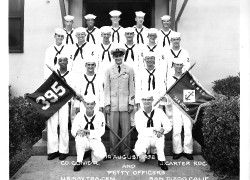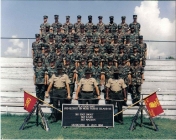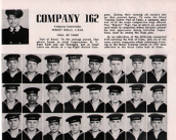Radio Telephone Operator / Vehicle Driver: Establishes, maintains, and operates radio communications and security equipment including encoding and decoding messages. Prepares and maintains daily staff journal, fire support situation map, status charts, capability overlay, and other fire support and target processing records. Assists in preparation and dissemination of fire support plans, coordinating documents, and target lists and provides liaison support. Assists in initiating requests for field artillery mortar, naval gunfire, and aerial delivered munitions. Emplaces, maintains, and assists in the operation of laser range finders, target designation, and night observation devices. Operates and performs operator maintenance on section vehicles and generators. Performs crew maintenance and participates in organizational maintenance of section equipment.
Target Processing Specialist: Establishes, maintains, and operates radio communications and security equipment including encoding and decoding messages. Prepares and maintains daily staff journal, fire support situation map, status charts, capability overlay, and other fire support and target processing records. Assists in preparation and dissemination of fire support plans, coordinating documents, and target lists and provides liaison support. Assists in initiating requests for field artillery mortar, naval gunfire, and aerial delivered munitions. Emplaces, maintains, and assists in the operation of laser range finders, target designation, and night observation devices. Operates and performs operator maintenance on section vehicles and generators. Performs crew maintenance and participates in organizational maintenance of section equipment.
COLT / KNIGHT Chief: Leads and trains the Combat Observation Lasing Team (COLT) or the KNIGHT Team in combat operations. Prepares observer target lists and assists in formulating offensive and defensive fire support plans. Initiates, requests, and adjusts field artillery, mortar, and naval gunfire using all methods of adjustment including continuous and coordinated illumination. Initiates suppressive and screening fire to support the scheme of maneuver and performs crater analysis. Selects and occupies the observation post (OP).
Fire Support Sergeant: Serve as an assistant to the FSO and FSNCO in coordinating FS. Supervise the FS specialists. Maintain and update FS status charts and situation maps. Maintain the staff journal. Coordinate with the maneuver brigade operations sergeant to properly integrate the FSE into brigade TOC operations, to include physical arrangements of FSE equipment, responsibilities involving TOC operations and security, and TOC standing operating procedures (SOP).
Forward Observer: Assists the fire support sergeant in the training of subordinates in fire support procedures, techniques, and tactics, and supervision of section operations, maintenance, and training. Leads and trains the Forward Observer Team. Prepares observer target lists and assists in formulating offensive and defensive fire support plans. Initiates, requests, and adjusts field artillery, mortar, and naval gunfire using all methods of adjustment including continuous and coordinated illumination. Initiates suppressive and screening fire to support the scheme of maneuver and performs crater analysis. Selects and occupies the observation post (OP).
Fire Support Team Chief: Instructs, advises, and evaluates forward observers and fire support personnel in tactics, techniques, and procedures. Supervises the performance of operator, crew, and organizational maintenance on section vehicles and equipment. Leads and trains the fire support team (FIST) operations at company level. Supervises and directs the construction, camouflage, and defense of the section position. Assists senior targeting NCO in targeting cells.
Targeting NCO: Recommend the organization for combat for TA assets. Participate as a member of the targeting team. Analyze targets for possible engagement. Plan interdiction targets for attack. Assist in determining the HPTL, AGM, and the TSS. Interface with the targeting personnel in the FSE’s in subordinate units and higher headquarters (such as the joint targeting coordination board (JTCB). Keep the FAIO informed of changes to the HPTL, TSS, and AGM. Pass targets received from the FAIO to attack systems in the most expedient manner. Advise and inform the FSCOORD on issues concerning targeting and radar employment. Assist the operations and FA intelligence personnel in the FSE with their function as required.
Fire Support Sergeant: Leads and trains the targeting elements of the Fires Brigade or the fire support element at battalion or higher levels during combat operations. Advises and assists fire support sergeants of subordinate elements in fire planning and coordination techniques. Drafts fire support plans for tactical operations orders and plans. Coordinates plans for company, battalion, and brigade fire support and integrates them with the overall scheme of maneuver. Recommends the employment of fire support means to include naval gunfire and close air support. Recommends employment of target acquisition assets and target selection standards to include COLT / KNIGHT employment. Assists in the target analysis and fire planning at the brigade, division, and Corps fire support element (FSE). Supervises the performance of operator, crew, and organizational maintenance on section vehicles.
Operations Sergeant: Help maintain 24-hour operations in the FSE. Supervise the installation, operations, and maintenance, of equipment and communications in the FSE, and the operation and maintenance of FSE vehicles. Supervise the personnel in the FSE, and process administrative matters pertaining to the FSE personnel. Help the AFSCOORD prepare FS documents. Supervise the posting and maintenance of all FSE charts and records. Prepare required reports in accordance with local directives. Maintain classified files. Assemble and disseminate the FS related IR. Assist the operations and FA intelligence personnel in the FSE with their function as required.
Platoon Sergeant: The platoon sergeant is the primary assistant and advisor to the platoon leader with the responsibility of training and caring for soldiers. The platoon sergeant helps the commander to train the platoon leader and in that regard has an enormous effect on how that young officer perceives NCOs for the rest of his career. The platoon sergeant takes charge of the platoon in the absence of the platoon leader. As the lowest level senior NCO involved in the battery METL, platoon sergeants teach collective and individual tasks to soldiers in their sections or equivalent small units. A platoon sergeant or sergeant first class generally has extensive military experience and can make accurate decisions in the best interest of the mission and the soldier. Utilizing tough, realistic and intellectually and physically challenging performance-oriented training to excite and motivate soldiers, the platoon sergeant ensures Army standards are met and maintained. Additionally, the platoon sergeant must conduct cross training to promote critical wartime skills within the unit, evaluate the effectiveness of the platoon and provide training feedback to the commander and first sergeant during After-Action Reviews (AAR) on all unit collective training.
Targeting NCO: The 13F40 Targeting NCO is responsible for setup and operation of the target processing section. His duties include: Leads, supervises, and trains the targeting element. Sets up and maintains all targeting element maps, charts, and records. Ensures AFATDS is properly initialized and used in conjunction with the targeting information from the target production map and other sources to produce targets. Assists in recommending employment of fire support means to include Naval Gunfire and CAS. Ensures targets generated by the targeting element are passed to the fire control and operations elements for action. Ensures information from shelling reports (SHELREPs) and mortar bombing reports (MORTREPs) are integrated into the target development process. Helps maintain the artillery order of battle database and target files.

Field Artillery Center/School, Fort Sill, OK
Information For Course 250-13F10
School: 061 School Location: FT SILL, OK
Course Title: FIRE SUPPORT SPECIALIST
FY: 2009 School: 061 Course: 250-13F10 Phase: Course Length: 6 Weeks 0.0 Days
Verifiable Prerequisites Prerequiste Item Value(s) or Range Constraint PULHES 111111 Required
Normal Red/Green (RG) Perception YES Required
Physical Demand Rating VERY HEAVY - LIFT OCCASIONAL OVER 100 LB, FREQUENT 50 LB Required
Male Gender Requirement YES Required
Must be a U.S. Citizen YES Required
Course Security Clearance Y - NONE Required
ASVAB FA Score 096 Required
Prerequisite Courses
There are no Prerequisite Courses.
Text Prerequisites
Active Army and Reserve Component enlisted personnel upon entry into MOS 13F10. The soldier must meet the enlistment standards prescribed in DA PAM 611-21 for MOS 13F Fire Support Specialist.
Course Scope:
This course provides a logical progression of individual skills and tasks selected to develop a well disciplined, motivated soldier proficient in entry level tasks and institutionally training MOS technical skills. This course develops self-disciplined, motivation, physical readiness, proficiency in basic combat survivability, combat techniques, individual weapons, and those technical skills needed to become a member of a Fire Support Team.




